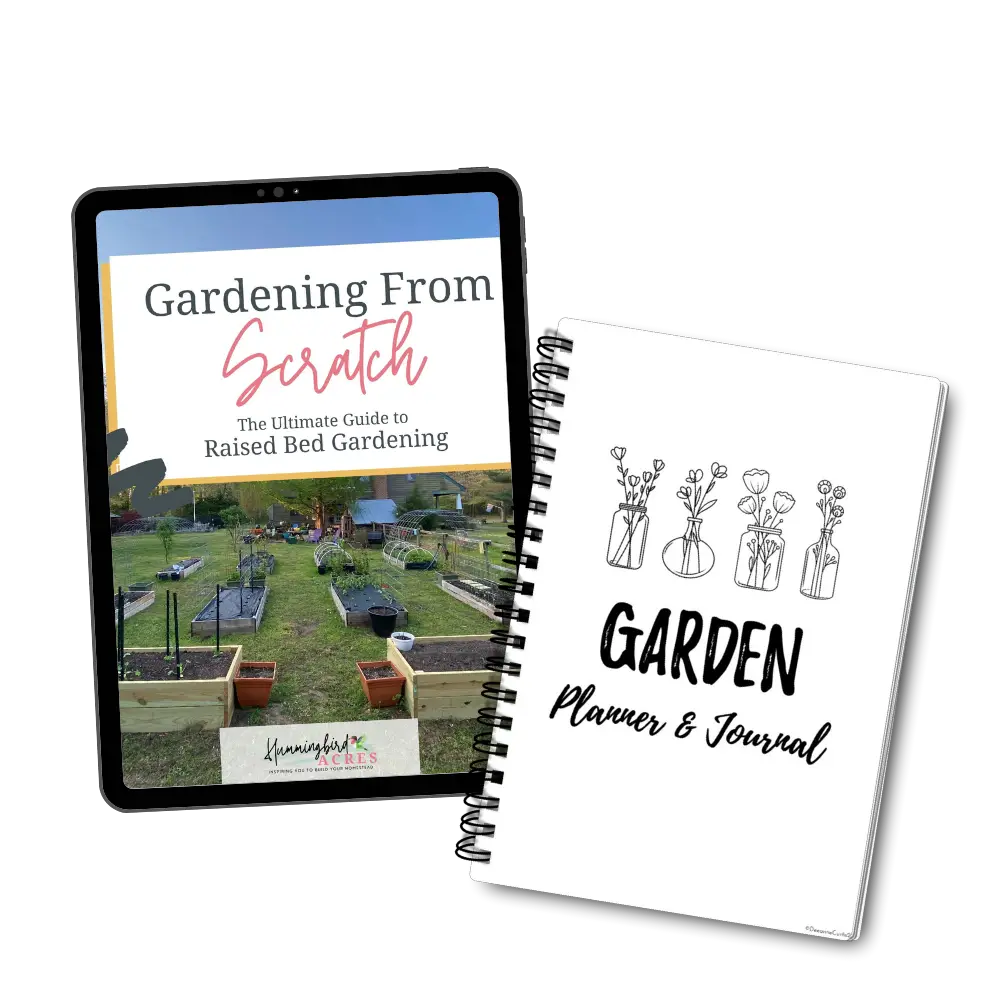Butterfly Plants for Shade: Top 10 Options for Your Garden
Are you looking to attract butterflies to your shaded garden? While it’s true that these colorful insects usually require direct sunlight to thrive, there are still plenty of butterfly plants that can grow in the shade. By planting the right types of flowers, you can create a vibrant and inviting habitat for butterflies to visit and even lay their eggs.
Some of the best butterfly plants for shade gardens include Monarda Moonbeam, Coreopsis, and Sweet Alyssum. These plants produce nectar-rich blooms that butterflies love, and they can thrive in areas with partial shade. Additionally, ferns and hostas are great foliage options that can provide shelter and food for caterpillars and adult butterflies alike. With a little bit of planning and care, you can create a beautiful butterfly garden in even the shadiest of spots.
Disclosure: As an Amazon affiliate, I earn from qualifying purchases at no extra cost to you. My blog contains other affiliate links as well for your convenience. To learn more, you may read my Disclosure Policy. Thank you for supporting my blog!
Understanding Shade in Butterfly Gardens
When planning a butterfly garden in a shady area, it is essential to understand the different types of shade. Shade can range from dappled shade, where sunlight filters through the leaves of trees and plants, to deep shade, where very little sunlight reaches the ground. Understanding the level of shade in your garden is crucial in selecting the right plants for your butterfly garden.
Butterfly plants for shade gardens typically require less sunlight than those for full sun gardens. However, some shade-loving plants can still thrive in partial sun or bright, indirect light. It is essential to choose plants that are appropriate for the specific amount of sunlight your garden receives. For example, some butterfly plants, such as impatiens and lobelia, can tolerate partial shade, while others, such as astilbes, require consistent moisture and thrive in full shade.
In addition to sunlight, consistent moisture is also crucial for butterfly plants in shade gardens. Many shade-loving plants require moist soil to thrive, making them ideal for rain gardens or areas with poor drainage. Adding organic matter, such as compost or leaf mold, to the soil can help retain moisture and improve soil quality.
When selecting plants for a shade garden, consider incorporating a variety of colors and textures. Butterflies are attracted to bright, bold colors such as red, pink, yellow, and orange. Consider planting a mix of flowers, shrubs, and grasses to provide a diverse habitat for butterflies and other pollinators.
Overall, understanding the level of shade in your garden, selecting appropriate plants for the amount of sunlight and moisture, and incorporating a variety of colors and textures can help create a thriving butterfly garden in a shady area.
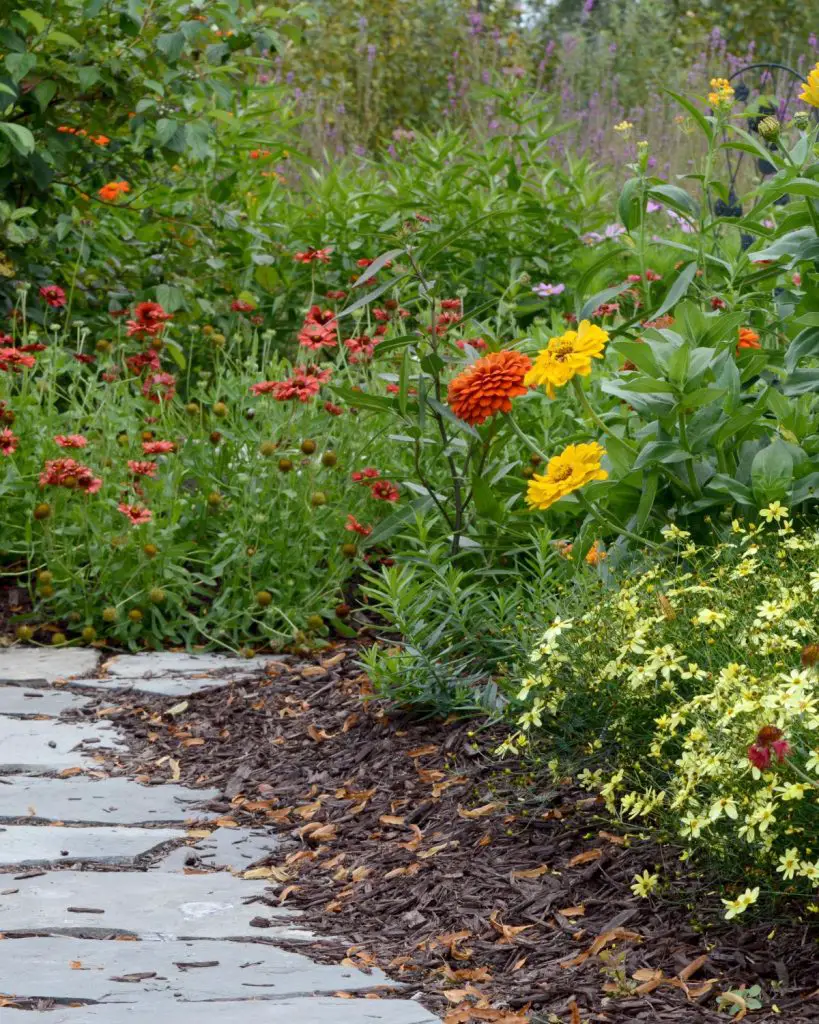
Choosing the Right Plants for Shade
When it comes to choosing the right plants for your shade garden, there are a few things to keep in mind. First, consider the amount of light your garden receives. Some plants require partial shade, while others can thrive in full shade.
Next, think about the type of plant you want to include in your garden. Are you looking for a perennial that will come back year after year, or an annual that will provide a burst of color for one season?
It’s also important to consider whether the plant is native or invasive to your area. Native plants are well-adapted to the local climate and soil conditions, and they provide important habitat for local wildlife. Invasive plants, on the other hand, can outcompete native species and disrupt the local ecosystem.
When selecting perennials, look for cultivars that are well-suited to your growing conditions. Some perennials are better suited to shade than others, and some cultivars may be more disease-resistant or have longer bloom times than others.
Consider incorporating groundcover plants into your shade garden as well. Groundcovers can help to suppress weeds, retain moisture in the soil, and provide important habitat for insects and other wildlife.
Finally, if you want to attract butterflies to your shade garden, be sure to include host plants and nectar-rich plants. Host plants provide food for butterfly larvae, while nectar-rich plants provide a source of food for adult butterflies. Some good options for shade include astilbe, columbine, and impatiens.
By carefully selecting the right plants for your shade garden, you can create a beautiful and thriving ecosystem that provides habitat for local wildlife and adds beauty to your outdoor space.
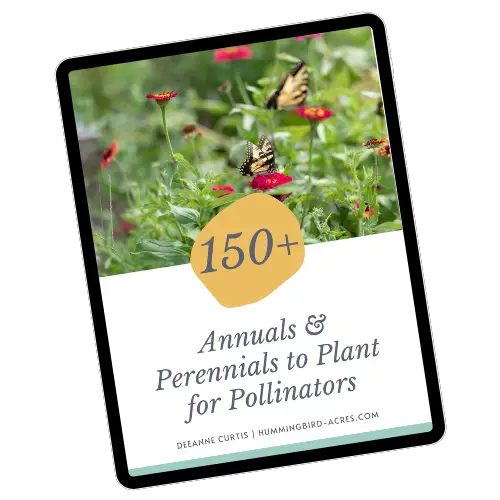
Grab my free
150 Plants for Pollinators
Plant These to Attract Butterflies and Pollinators to Your Garden!
Enter your name & email so we can send you your FREE Guide.
[convertkit form=5600487]
Importance of Color in Attracting Butterflies
When it comes to attracting butterflies to your garden, color is an important factor to consider. Butterflies are attracted to bright, vibrant colors, especially shades of red, yellow, orange, pink, and purple. These colors are thought to resemble the flowers that butterflies feed on in the wild, making them more likely to visit your garden.
One of the most popular plants for attracting butterflies is the purple coneflower. This plant features large, daisy-like flowers in shades of pink, purple, and white. The purple coneflower is a favorite of many butterfly species, including the eastern tiger swallowtail and the painted lady.
Another great plant for attracting butterflies is the bicolor butterfly bush. This plant features long, slender flowers in shades of violet and pink. The bicolor butterfly bush is a favorite of many butterfly species, including the monarch and the swallowtail.
When choosing plants for your butterfly garden, it’s important to consider the color of the flowers. Planting a variety of colors will attract a wider range of butterfly species to your garden. Additionally, planting flowers that bloom at different times throughout the year will provide a consistent food source for butterflies, ensuring that they return to your garden year after year.
In summary, when it comes to attracting butterflies, color is key. Planting a variety of bright, vibrant colors, like shades of violet and purple, will help attract a wide range of butterfly species to your garden. Additionally, planting a variety of flowers that bloom at different times throughout the year will provide a consistent food source for butterflies, ensuring that they return to your garden year after year.
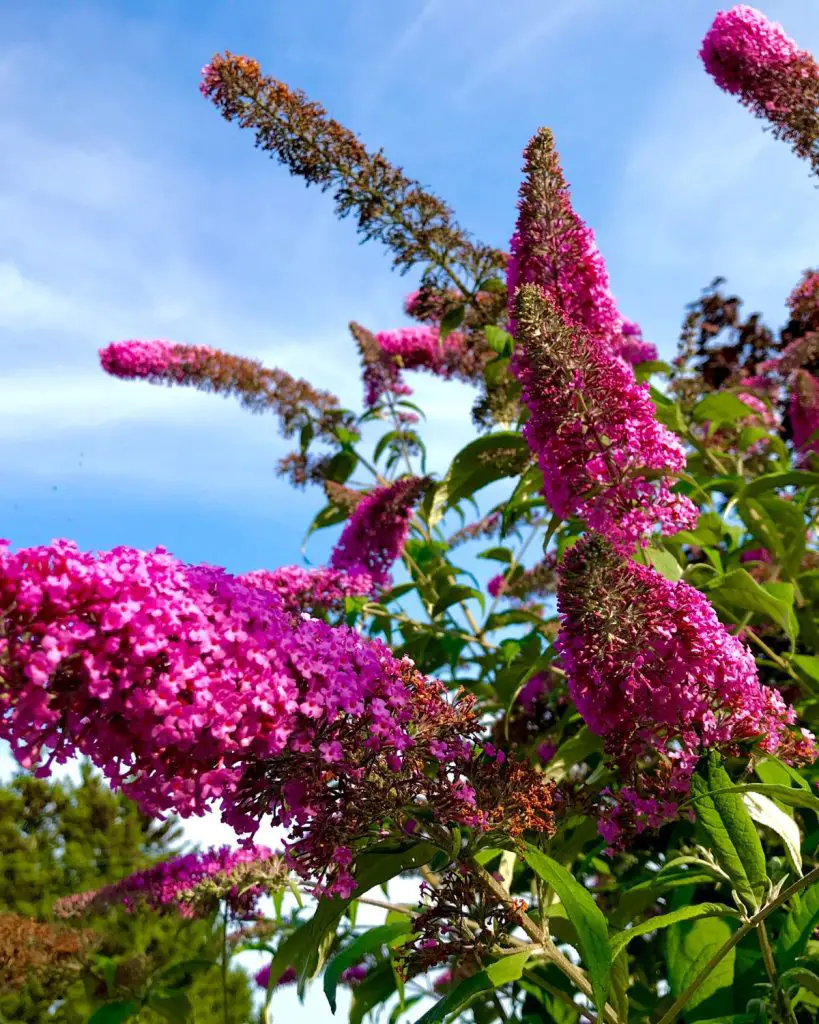
Top Butterfly Plants for Shade
When it comes to attracting butterflies to your garden, planting the right flowers is crucial. If you have a shady spot, don’t worry, there are plenty of butterfly plants that will thrive in those conditions. Here are some of the best options to consider:
Asters
Asters are a great choice for shady areas, and they come in a variety of colors, including pink, purple, and blue. They bloom in late summer and fall, which is perfect timing for migrating butterflies.
Butterfly Bush
Butterfly bush, also known as buddleia, is a popular choice for attracting butterflies. It has long, cone-shaped flowers that come in shades of pink, purple, and white. It blooms in mid to late summer and is a favorite of many butterfly species.
Milkweed
Milkweed is a must-have plant if you want to attract monarch butterflies. It is the only plant that monarch caterpillars will eat, so it’s essential for their survival. Milkweed comes in a variety of species, including common milkweed, swamp milkweed, and butterfly weed.
Monarda
Monarda, also known as bee balm or bergamot, is a native plant that attracts a variety of pollinators, including butterflies. It has showy flowers in shades of pink, red, and purple and blooms in mid to late summer.
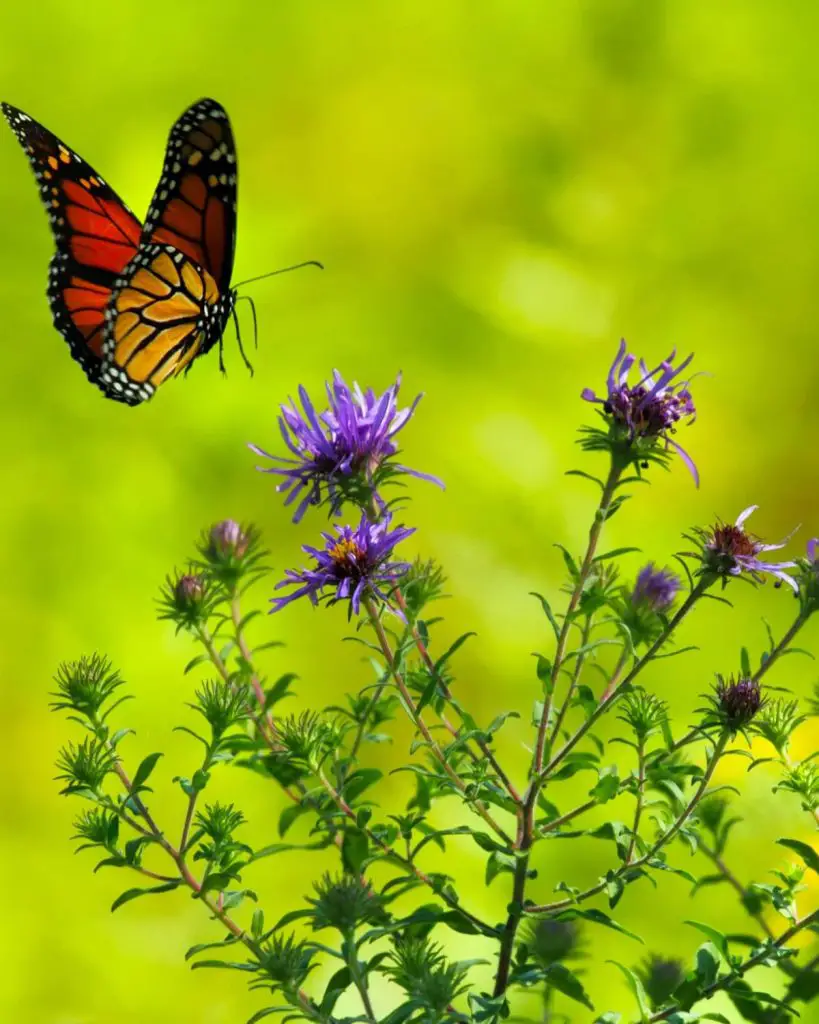
Rudbeckia
Rudbeckia, also known as black-eyed Susan, is a hardy plant that thrives in a variety of conditions, including shade. It has bright yellow flowers with dark centers and blooms from midsummer to fall.
Coneflower
Coneflower, also known as echinacea, is a popular choice for attracting butterflies and other pollinators. It has daisy-like flowers in shades of pink, purple, and white and blooms from midsummer to fall.
Cardinal Flower
Cardinal flower is a native plant that attracts hummingbirds and butterflies with its bright red flowers. It blooms in mid to late summer and prefers moist soil.
Joe Pye Weed
Joe Pye weed is a tall, native plant that attracts a variety of pollinators, including butterflies. It has clusters of pink or purple flowers and blooms in late summer and fall.
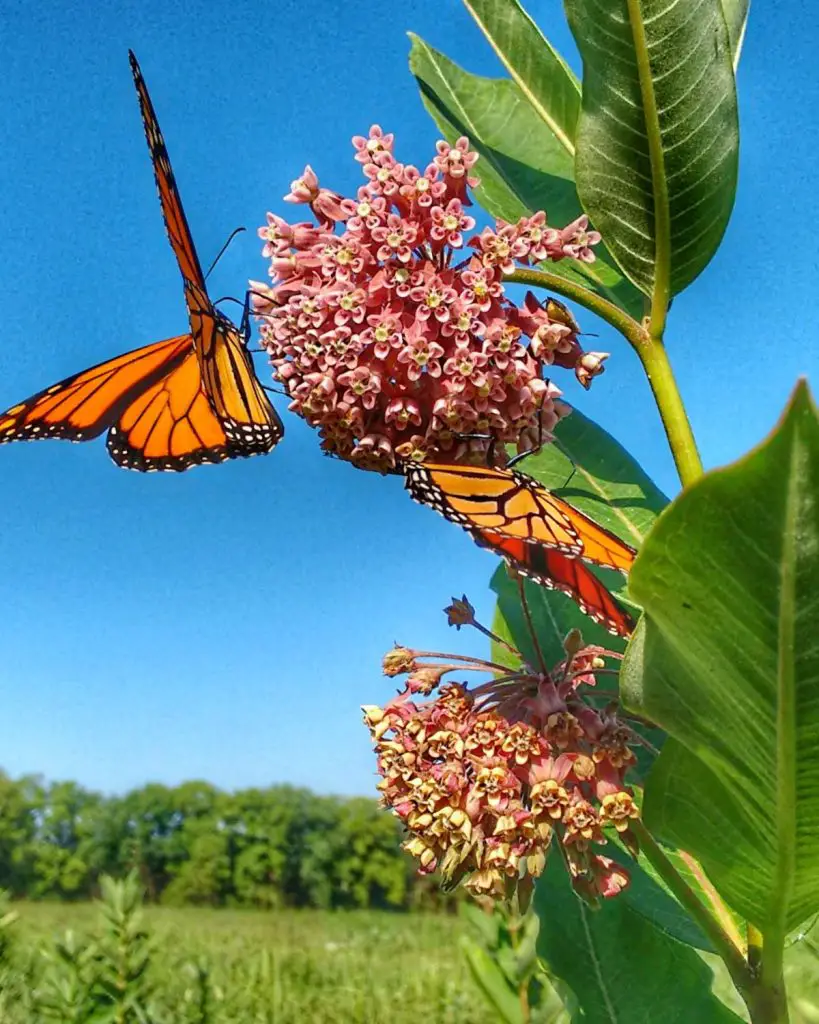
Solidago
Solidago, also known as goldenrod, is a native plant that attracts a variety of pollinators, including butterflies. It has yellow flowers and blooms in late summer and fall.
Ageratum
Ageratum is a low-growing plant with fluffy blue or pink flowers. It blooms from midsummer to fall and attracts a variety of butterflies.
Dill
Dill is an herb that attracts a variety of butterflies, including swallowtails. It has feathery leaves and yellow flowers that bloom in midsummer.
Foxglove
Foxglove is a tall plant with spires of bell-shaped flowers in shades of pink, purple, and white. It blooms in midsummer and attracts a variety of butterflies.
Nicotiana
Nicotiana, also known as flowering tobacco, has tubular flowers in shades of pink, white, and red. It blooms from midsummer to fall and attracts a variety of butterflies.
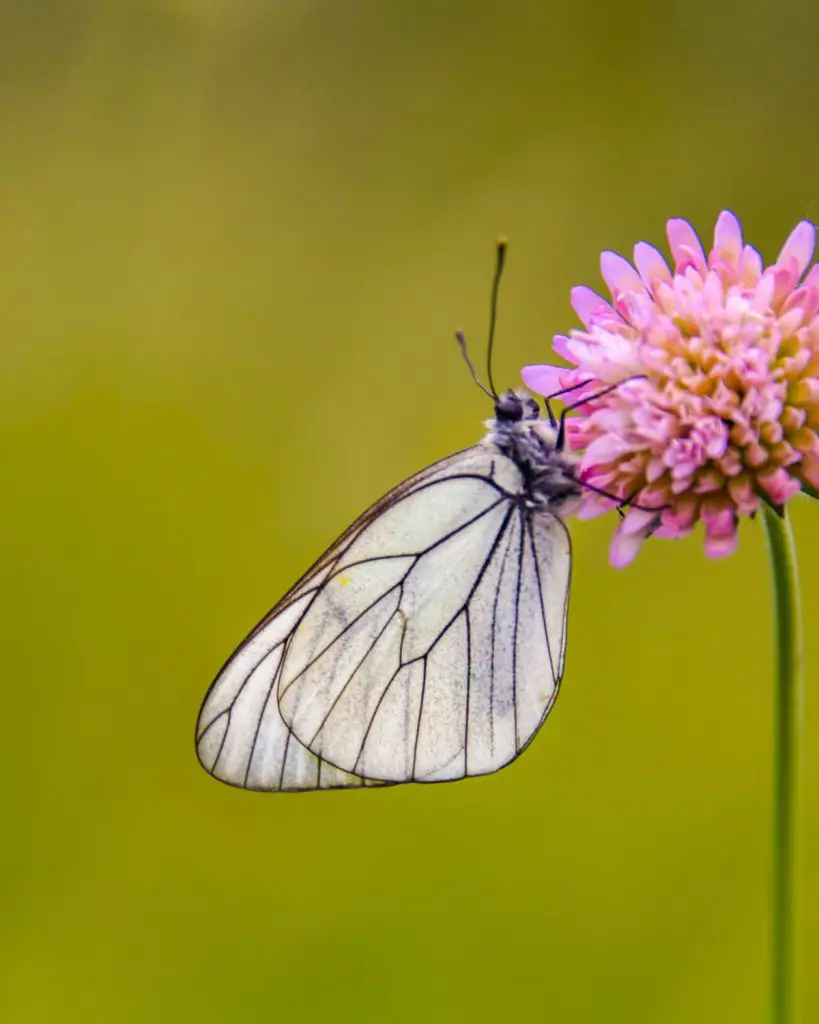
Coreopsis
Coreopsis is a low-growing plant with daisy-like flowers in shades of yellow, pink, and red. It blooms from midsummer to fall and attracts a variety of butterflies.
Stonecrop
Stonecrop, also known as sedum, is a succulent plant with clusters of star-shaped flowers in shades of pink, red, and white. It blooms in late summer and fall and attracts a variety of butterflies.
Honeysuckle
Honeysuckle is a vine with fragrant flowers in shades of pink, yellow, and white. It blooms from late spring to fall and attracts a variety of butterflies.
Impatiens
Impatiens is a popular annual plant with bright, showy flowers in shades of pink, red, and white. It blooms from midsummer to fall and attracts a variety of butterflies.
Columbine
Columbine is a native plant with unique, bell-shaped flowers in shades of red, pink, and blue. It blooms in late spring and early summer and attracts a variety of butterflies.
Parsley
Parsley is an herb that attracts swallowtail butterflies. It has feathery leaves and small, greenish-yellow flowers that bloom in midsummer.
Dianthus
Dianthus, also known as pinks, has fragrant flowers in shades of pink, red, and white. It blooms from late spring to fall and attracts a variety of butterflies.
Globe Amaranth
Globe amaranth has bright, showy flowers in shades of pink, purple, and white. It blooms from midsummer to fall and attracts a variety of butterflies.
Lobelia
Lobelia is a native
Understanding the Role of Butterflies and Other Pollinators
If you’re looking to create a butterfly garden in a shaded area, it’s important to understand the role of butterflies and other pollinators. Butterflies, hummingbirds, bees, and other pollinators play a crucial role in plant reproduction, helping to transfer pollen from one flower to another.
Butterflies, in particular, are important pollinators for many plant species. There are over 700 species of butterflies in North America alone, with many of them playing a crucial role in pollination. Some of the most common butterfly species that you might see in a shaded garden include swallowtails, such as the spicebush swallowtail.
When planning your butterfly garden, it’s important to choose plants that will attract these pollinators. Butterflies are attracted to brightly colored flowers that are rich in nectar, such as asters, coneflowers, and black-eyed susans. Hummingbirds, on the other hand, are attracted to red, tubular flowers, such as bee balm and cardinal flower.
In addition to providing food for pollinators, your butterfly garden can also serve as a habitat for these important creatures. Butterflies, in particular, need a place to lay their eggs and for their caterpillars to feed. By including host plants, such as milkweed for monarch butterflies, you can help to support the entire life cycle of these pollinators.
Overall, by understanding the role of butterflies and other pollinators, you can create a beautiful and functional garden that will support these important creatures.

Get our
Secret Guide to Butterfly Gardening
Everything you need to start and maintain a vibrant and colorful butterfly garden.
Caterpillar Host Plants and Butterfly Larvae
If you want to attract butterflies to your shaded garden, it’s important to know which plants caterpillars love to feed on. Caterpillar host plants are the plants where butterflies and moths lay their eggs. These plants are essential for the survival of butterfly larvae, as they provide food and shelter during their early stages of life. Here are some caterpillar host plants that thrive in shaded areas:
- Pipevine: The pipevine plant is a great host plant for the pipevine swallowtail butterfly. These caterpillars love to feed on the leaves of the pipevine plant, and they will eat a lot of it before they pupate.
- Spicebush: The spicebush is a shrub that is native to the eastern United States. It is a host plant for the spicebush swallowtail butterfly. These caterpillars love to feed on the leaves of the spicebush, and they will eat a lot of it before they pupate.
- Hackberry: The hackberry tree is a host plant for many different species of butterflies, including the hackberry emperor, tawny emperor, and mourning cloak. These caterpillars love to feed on the leaves of the hackberry tree, and they will eat a lot of it before they pupate.
- Willow: The willow tree is a host plant for many different species of butterflies, including the viceroy, red-spotted purple, and mourning cloak. These caterpillars love to feed on the leaves of the willow tree, and they will eat a lot of it before they pupate.
- Oak: The oak tree is a host plant for many different species of butterflies, including the red-spotted purple, banded hairstreak, and white-M hairstreak. These caterpillars love to feed on the leaves of the oak tree, and they will eat a lot of it before they pupate.
It’s important to note that caterpillar host plants should be planted in large enough quantities to support the number of caterpillars that will be feeding on them. Additionally, it’s important to avoid using pesticides on these plants, as they can harm the caterpillars and butterflies. By providing caterpillar host plants in your shaded garden, you can help support the butterfly population and enjoy the beauty of these insects in your backyard.

Creating a Butterfly-Friendly Habitat
If you want to attract butterflies to your shaded garden, creating a butterfly-friendly habitat is a must. Here are some tips to help you create a welcoming environment for these beautiful creatures:
Choose the Right Butterfly Plants
Butterflies are attracted to specific plants, so choosing the right plants is essential. Some of the best butterfly plants for shaded gardens include:
- Astilbe
- Bleeding Heart
- Columbine
- Coral Bells
- Ferns
- Hostas
- Impatiens
- Jacob’s Ladder
- Lungwort
- Solomon’s Seal
- Sweet Woodruff
- Wild Ginger
Provide Shelter and Water
Butterflies need shelter from the wind and rain, so make sure you provide them with some protection. You can do this by planting your butterfly plants near a wall or fence, or by adding some tall plants to your garden. You should also provide a source of water for your butterflies. A shallow dish filled with water and some rocks or pebbles for the butterflies to land on is perfect.
Add Fragrance
Butterflies are also attracted to fragrance, so adding some fragrant plants to your garden is a good idea. Some of the best fragrant butterfly plants for shaded gardens include:
- Bee Balm
- Dianthus
- Honeysuckle
- Lilac
- Phlox
- Sweet Alyssum
Avoid Pesticides
Pesticides are harmful to butterflies, so avoid using them in your garden. Instead, use natural pest control methods like companion planting and handpicking pests.
By following these tips, you can create a butterfly-friendly habitat in your shaded garden and attract these beautiful creatures to your yard.
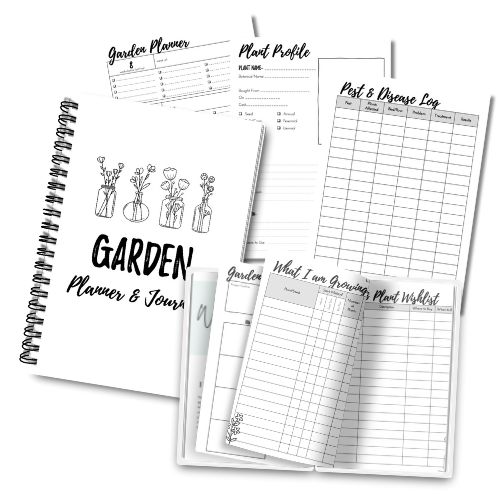
Get our
Garden Planner & Journal
Everything you need to start and maintain a successful garden. Take the guess work out of what to plant where and when to start your seeds.
Planting and Maintenance Tips
Planting butterfly plants in shaded gardens can be a great way to attract winged visitors to your garden. Here are some tips to help you get started:
Soil and Planting
When planting butterfly plants, it’s important to choose the right soil. Most butterfly plants prefer well-drained soil that is rich in organic matter. If you have clay soil, consider adding compost or other organic matter to improve drainage and soil quality.
When planting, make sure to dig a hole that is twice as wide as the root ball. This will help the roots spread out and establish themselves more quickly. After planting, water the plant thoroughly to help it settle into its new home.
Watering and Mulching
Butterfly plants generally prefer consistent moisture, especially during the summer months. However, they can also be drought-tolerant once established. To help conserve moisture and keep the soil cool, consider adding a layer of mulch around the base of the plant.
Late Summer and Fall Care
In late summer and fall, it’s important to deadhead your butterfly plants to encourage new growth and prevent self-seeding. You can also cut back the plants by about one-third to help them prepare for winter.
Low-Maintenance Options
If you’re looking for low-maintenance butterfly plants, consider planting ferns, hostas, or bleeding hearts. These plants are all shade-tolerant and require minimal care once established.
Container Gardens
Butterfly plants can also be grown in containers, which is a great option for those with limited space or poor soil quality. When planting in containers, make sure to choose a pot that is at least 12 inches in diameter and has drainage holes. Use a high-quality potting mix and water regularly to keep the soil moist.
By following these tips, you can create a beautiful and thriving butterfly garden in your shaded space.

Beneficial Aspects of Native and Non-Invasive Plants
When choosing plants for your butterfly garden, it is important to consider the impact they will have on the surrounding ecosystem. Native plants are always a great choice as they have evolved alongside local wildlife and provide the necessary resources for their survival. Non-invasive plants are also important as they do not spread aggressively and compete with native species.
Native plants are especially important for supporting the life cycle of butterflies. For example, Monarch butterflies rely on milkweed plants as their sole host plant for laying eggs and feeding caterpillars. By planting native milkweed species like Asclepias syriaca or Asclepias tuberosa, you can provide a critical habitat for Monarchs and other butterfly species.
Non-invasive plants are also important for maintaining a healthy ecosystem. Invasive species can outcompete native plants, reducing biodiversity and harming local wildlife. Some invasive plants, like Japanese honeysuckle or Chinese privet, may provide nectar for butterflies, but they also have negative impacts on the surrounding environment.
When selecting non-invasive plants for your butterfly garden, consider species that are known to be beneficial for pollinators. For example, the native spicebush (Lindera benzoin) produces fragrant flowers in early spring that provide nectar for early emerging butterflies and bees. Additionally, the red berries produced by some native plants like winterberry (Ilex verticillata) can provide a valuable food source for birds during the winter months.
By choosing native and non-invasive plants for your butterfly garden, you can help support local wildlife and maintain a healthy ecosystem.
You may also enjoy these related articles:
- Grow Butterfly Weed for a Beautiful Butterfly Garden
- Plants for Butterfly Gardens: Attract More Butterflies to Your Yard with These Beautiful Flowers
- Plan Your Own Butterfly Garden: A Beginner’s Guide
Did you enjoy this article? Want to hear more? Stay in touch! Sign up below to receive weekly tips and inspiration for your homestead.
